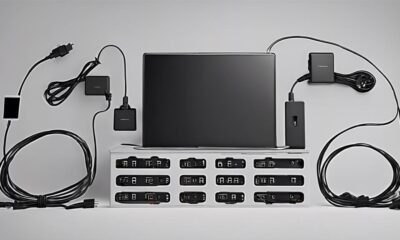Decor
Navigating the Future of Design Leadership

Did you know that design is no longer just about aesthetics? In fact, it has become a strategic force that drives innovation and connects technology with what is meaningful for people. Design leadership is evolving, and its future role is more critical than ever before.
In an interview with Design leaders and experts, including Eric Quint, former Chief Brand and Design Officer at 3M, we delve into the complexities of design leadership and explore its role in shaping the future of design. We discuss how design thinking, digitalization, and AI are transforming the design landscape, and how design leaders have the opportunity to redefine boundaries, promote equity and sustainability, and shape future visions for positive impact.
If you’re eager to learn more about the future of design leadership and how it can drive innovation and creativity, keep reading.
Key Takeaways
- Design is no longer just about aesthetics; it is a strategic force that drives innovation.
- Design leadership involves anticipating future needs and leveraging digital capabilities.
- Design thinking is an important aspect of design leadership, addressing complex challenges.
- Digitalization and AI are shaping the future of design, enabling new tools for collaboration and validation of solutions.
- Design leaders have the opportunity to shape future visions for positive impact in the world.
The Definition of Design and Design Thinking
Design is the embodiment of creativity for a purpose, implemented with empathy. It goes beyond aesthetics and encompasses problem definition, analysis, and solution finding. As designers, we contribute to value creation by generating and shaping ideas into effective solutions that address complex challenges. Design thinking requires multidisciplinary collaboration, integrating knowledge from fields such as anthropology, sociology, and business modeling.
While design thinking workshops and tools like Post-It notes are commonly associated with the process, the future of design thinking lies in digitalization and the use of AI for enhanced creativity and problem-solving.
Design Thinking Process
- Empathize: Understand users and gain insights into their needs and experiences.
- Define: Define the problem and create a clear problem statement.
- Ideate: Generate a wide range of ideas and potential solutions.
- Prototype: Build a tangible representation of the solution for testing and feedback.
- Test: Gather feedback, iterate on the solution, and refine it based on user insights.
Design thinking encourages us to approach problem-solving with creativity, empathy, and user-centricity, ensuring that the solutions we create truly meet the needs and desires of the people we design for.
Design thinking is a powerful framework that helps us tackle complex challenges and create innovative solutions. It guides us in merging creativity and problem-solving to address the diverse needs of individuals and society as a whole.
The Impact of Digitalization on Design and Design Thinking
Digitalization has revolutionized the world of design, transforming the way designers contribute value and pushing the boundaries of creativity. With the advent of computer-aided design (CAD), designers gained powerful tools that revolutionized their workflow and allowed for more precise and efficient designs. Today, digital platforms and advanced research tools are taking design to new heights, enabling collaboration, analysis, and scenario modeling like never before.
Design tools:
- Computer-aided design (CAD)
- Digital sketching and prototyping software
- Virtual reality (VR) and augmented reality (AR) tools for immersive design experiences
- 3D modeling and animation software
One popular tool, Miro, has become an indispensable platform for designers seeking co-creative dialogue and participatory collaboration. It allows team members to seamlessly collaborate across boundaries, whether they are working remotely or together in a physical space. With Miro, designers can share ideas, brainstorm, and collectively shape the design process, fostering a culture of collaboration and teamwork.
Furthermore, artificial intelligence (AI) is making its mark in the world of design. AI algorithms are becoming more sophisticated, capable of performing tasks and even composing art. While AI offers exciting possibilities for design, designers must strike a delicate balance to ensure that the human element of empathy and creativity remains at the core of the design process.
Considerations when leveraging AI:
- Preserving human empathy in design decision-making
- Maintaining the human touch and creativity in the design process
- Respecting intellectual property rights in AI-generated designs
As designers navigate the digital landscape, they are constantly exploring new horizons and finding innovative ways to leverage digitalization and AI to enhance their design solutions. It’s an exciting time to be a designer, where technology acts as a catalyst for creativity and collaboration. By embracing digitalization and harnessing the power of AI while staying true to their creative roots, designers can create transformative and meaningful experiences that shape the future of design.
“Digitalization and AI have opened up new realms of possibilities for design. We can now collaborate across borders seamlessly, leverage advanced tools for analysis and modeling, and even count on AI for inspiration. The key is to always keep the human element and creativity at the heart of our designs.” – Jane Collins, Senior Design Lead at XYZ Design Studio.
Design and Digitalization Statistics:
| Statistic | Percentage/Number |
|---|---|
| Percentage of designers using digital tools for design analysis | 85% |
| Number of design projects utilizing digital collaboration platforms | 2.5 million |
| Percentage of designers leveraging AI algorithms in their design process | 42% |
| Number of design teams using Miro for collaborative design work | 10,000+ |
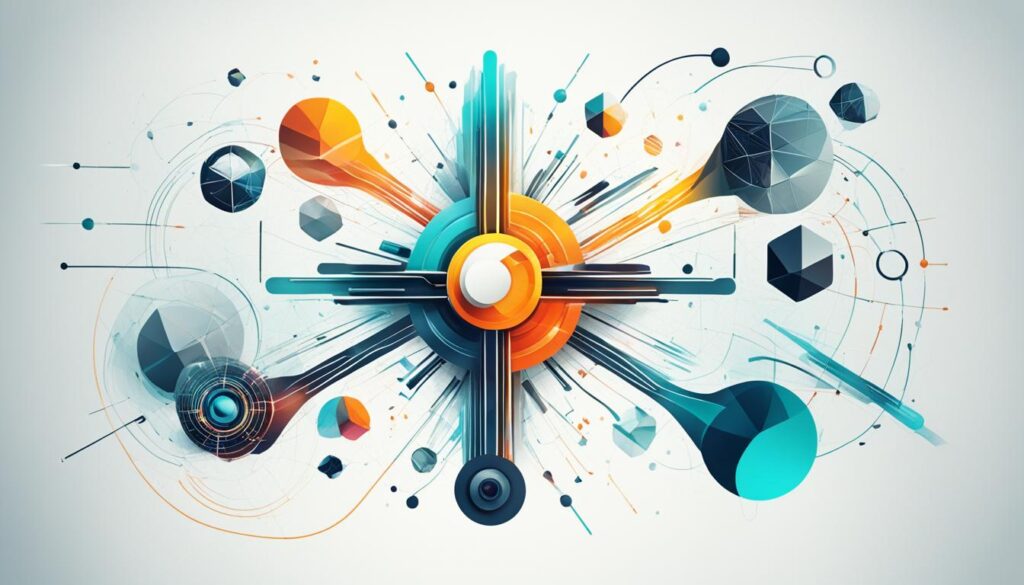
The Bigger Picture: Design, Equity, and Sustainability
As design leaders, it is our responsibility to redefine boundaries and explore the intersection of design with equity and sustainability. Our design visions must go beyond the narrow focus on customers and shareholders and consider the broader impact on society as a whole. By embracing empathy, creativity, and imagination, we can effectively address the systemic challenges that lie ahead.
The UN Sustainable Development Goals provide a powerful framework that showcases the complexity and scale of these challenges. From eradicating poverty to combating climate change, design has a crucial role to play in achieving these goals. By integrating sustainable and equitable practices into our design processes, we can contribute to positive and lasting impact.
To drive change at a larger scale, it is essential for design leaders to engage with business leaders and policy makers. We need to initiate conversations and collaborations that inspire creativity and innovation with a purpose. By fostering a creative culture, we can shape the future visions that align with the UN Sustainable Development Goals and create a better world for generations to come.
“Design is not just about how things look; it’s about how they work and how they make people feel. With a focus on equity and sustainability, we can shape designs that truly make a difference in people’s lives.”
Engaging in Collaborations for Sustainable Innovation
Collaboration is key to achieving sustainable innovation. By bringing together diverse perspectives, we can tackle complex challenges from multiple angles and create comprehensive solutions. Design leaders are uniquely positioned to initiate and facilitate these collaborations, ensuring that different stakeholders contribute their expertise to the design process.
Let’s take a look at how design collaboration can drive sustainable innovation:
Benefits of Design Collaboration Examples Shared knowledge and expertise Partnerships with universities and research institutions Increased creativity and innovation Cross-industry collaborations with NGOs and non-profits Broader understanding of user needs Co-creation workshops with marginalized communities Enhanced advocacy and impact Collaboration with policy makers and government organizations
Through these collaborations, we can harness the power of design to create solutions that are not only aesthetically pleasing but also sustainable, equitable, and impactful.
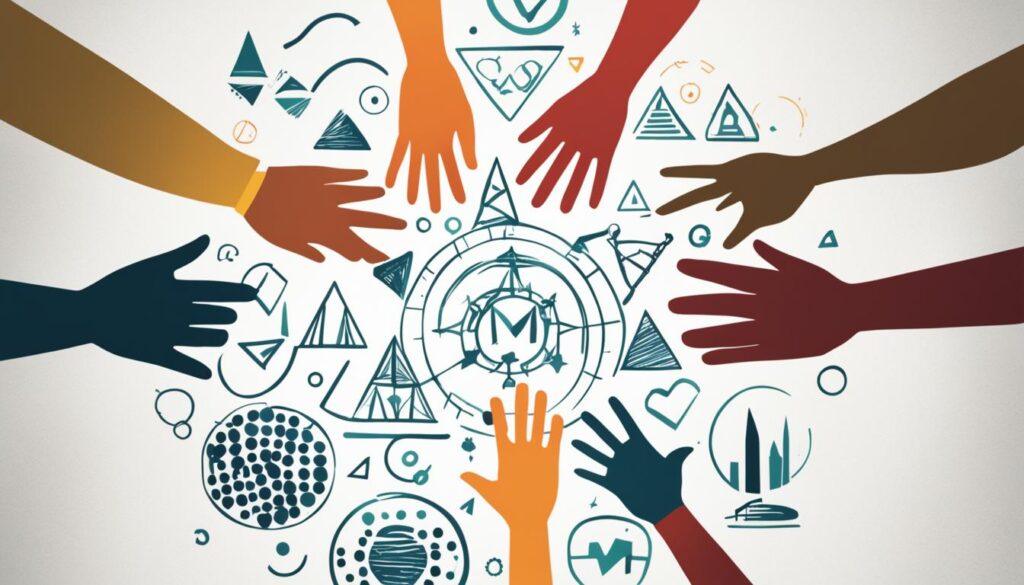
As design leaders, our role extends beyond aesthetics and problem-solving. We have the opportunity to shape the future by integrating equity and sustainability into our design practices. By collaborating with different stakeholders and aligning our work with the UN Sustainable Development Goals, we can create a positive impact that extends far beyond the design realm.
From the “Big Picture” to Everyday Practices
As design leaders, we are faced with the challenge of translating our ambitions into tangible outcomes within the organizational context. To achieve this, it is crucial for us to establish a design direction that aligns with the vision, mission, and strategy of our organization. This alignment ensures that our design efforts contribute effectively to the overall goals of the company.
But how do we navigate this journey from the “big picture” to everyday practices? One key aspect is design governance. It encompasses the rules of engagement, design organization structure, and design taxonomy that provide a foundation for scaling up design excellence and ensuring the seamless integration of design within the company.
Design governance allows us to establish processes, procedures, and guidelines that drive consistency, efficiency, and quality in our design activities. By defining clear roles, responsibilities, and decision-making frameworks, we enable effective collaboration and maximize the impact of design in the organization.
Furthermore, cultivating a design culture is vital for sustained success. Building a culture where excellence is constantly pursued fosters an environment where designers can thrive and contribute their best work. Empowering our teams to continuously learn, grow, and embrace innovative approaches creates a fertile ground for value creation.
“Design governance provides a foundation for scaling up design excellence and ensuring design integration within the company.”
An integral part of fostering a design culture is to champion the value of design at all levels of the organization. By actively promoting the strategic importance of design, we inspire others to recognize and appreciate the power it brings in driving innovation, differentiation, and growth.
The Benefits of Design Governance and Cultivating a Design Culture:
| Design Governance | Cultivating a Design Culture |
|---|---|
| Ensures consistency and quality in design activities | Fosters a collaborative and innovative environment |
| Defines clear roles, responsibilities, and decision-making processes | Empowers designers to continuously learn and grow |
| Maximizes the impact of design through effective integration | Encourages value creation and breakthrough thinking |
By embracing design governance and cultivating a design culture, we bridge the gap between our creative ambitions and the organizational realities. We create an environment that nurtures design excellence, empowers designers, and ensures that design remains at the forefront of our organization’s strategic vision.

Dualisms in Design Leadership and Post-Covid World
As design leaders, we often find ourselves navigating the conflicting demands of our role. Balancing ambitious goals with the realities of our organization’s constraints can be a delicate tightrope act. Likewise, reconciling the need for creative expression with the practicality of feasible solutions can pose a significant challenge.
In the post-Covid world, design leaders must adapt and embrace the new opportunities and challenges that have emerged. It is crucial to shift our focus from just providing immediate solutions to becoming skilled problem-finders. As rapid technological advancements reshape the design landscape, critical thinking becomes more vital than ever.
Developing strong design competences within our teams is key to unlocking their full potential. By fostering strategic insight, we can enable them to navigate complex design problems with finesse. This strategic insight allows us to see beyond the surface and anticipate future trends and user needs.
Looking further ahead, we must also prepare for a future where AI takes on routine design tasks. While AI offers efficiency and speed, it will be our critical thinking and human intuition that set us apart. Our design competences will be instrumental in defining the parameters and limitations of AI, ensuring it aligns seamlessly with our creative vision.

| Dualisms in Design Leadership | Post-Covid Adaptations |
|---|---|
| Balancing ambitions with organizational realities | Embracing new opportunities and challenges |
| Creativity vs. feasibility | Shifting focus to problem-finding |
| Developing design competences | Fostering strategic insight |
| Preparing for AI integration | Emphasizing critical thinking |
AI’s Impact on Creativity and the Ethical Considerations
AI is revolutionizing the creative industries, opening up new possibilities for innovation and design. However, this advancement also brings with it important ethical considerations that design leaders must navigate. As AI enhances creative capabilities, it is essential to ensure that it is used responsibly to preserve the essence of human creativity and uphold intellectual property rights.
Design leaders play a pivotal role in shaping the ethical implications of AI in the creative process. By considering the role of empathy in a world driven by AI, they can ensure that the human element is not lost and that ethical guidelines are integrated into the design practice.
“As AI becomes more prevalent in the creative industries, it is crucial for design leaders to address the ethical implications. We have a responsibility to foster a culture that values both technological advancement and the preservation of human creativity.”
The Impact on Creativity
The integration of AI into the creative process has the potential to revolutionize the way we approach design and generate innovative ideas. AI algorithms can analyze extensive data sets, identify patterns, and offer unique insights that can inspire creative solutions. This computational power can augment human capabilities, enabling designers to explore new possibilities and push the boundaries of creativity.
However, it is essential to remember that AI is a tool, and true creativity is a uniquely human attribute. Design leaders must strike a balance between leveraging AI’s capabilities while preserving the core elements of human thought, intuition, and imagination that drive genuine creative breakthroughs.
Protecting Intellectual Property
As AI becomes more involved in the creative process, it is crucial to uphold intellectual property rights. Design leaders must ensure that AI-generated designs respect existing copyrights and patents. By establishing clear guidelines, design leaders can protect the integrity of individual and organizational intellectual property.
Moreover, design leaders should be proactive in developing frameworks that assign ownership and attribution to AI-generated designs. This includes considering the ethical implications of AI-generated work and establishing protocols that protect the rights and recognition of human designers.
Cultivating Ethical Design Practices
Design leaders should foster a culture of ethical design practices that are guided by compassion, fairness, and transparency. By integrating ethical considerations into the design process, design leaders can ensure that AI is used responsibly and human values are upheld.
Design teams should engage in ongoing dialogue and reflection on the ethical implications of AI in design. This includes addressing questions around bias, privacy, and the impact of AI on societal values. By involving diverse perspectives and critically examining the potential risks and benefits, design leaders can guide their teams towards ethical decision-making and responsible innovation.

Artificial intelligence’s impact on creativity is an exciting frontier, but it also brings complex ethical considerations. Design leaders must champion ethical design practices that harness the power of AI while preserving the unique qualities of human creativity. By navigating these challenges with empathy and ethical guidelines, design leaders can shape a future where AI and human creativity coexist harmoniously.
The Fusion of Design and Strategy
Design leaders understand the importance of merging design thinking with strategic planning. Design is not just about aesthetics; it should solve real-world problems and align with business goals.
Strategic thinking is at the core of design strategy, enabling us to set clear goals, make informed decisions, and balance creativity with feasibility. By integrating design into the strategic planning process, we ensure that design becomes a driving force for innovation and a key enabler of business success.
When developing design strategy, we focus on creating a cohesive vision and strategy that aligns with our business objectives. We collaborate closely with stakeholders from all levels of the organization to ensure that our design efforts are aligned with their needs and aspirations. By doing so, we foster a sense of ownership and promote a shared vision that guides our design decisions.
Strategic thinking also helps us anticipate future challenges and opportunities, enabling us to adapt and evolve our design approach. By staying ahead of trends and market dynamics, we can proactively design solutions that address emerging customer needs and market demands.
Effective design strategy requires a deep understanding of our customers, competitors, and the broader market landscape. It empowers us to identify unique value propositions and differentiate ourselves from the competition.
To illustrate the importance of design strategy, let’s consider a hypothetical example of a company in the tech industry. Without a clear design strategy, the company may develop products that are visually appealing but fail to meet the needs of its target customers. In contrast, with a strong design strategy, the company can create products that not only look great but also offer innovative features and seamless user experiences, leading to increased customer satisfaction and loyalty.
Design Strategy: Key Considerations
When formulating our design strategy, we take into account several key considerations:
- Business goals: We align our design strategy with our overall business goals, ensuring that every design decision contributes to the achievement of our objectives.
- User-centric approach: We place the needs and preferences of our customers at the center of our design strategy, aiming to create products and experiences that resonate with them.
- Competitive analysis: We conduct thorough research and analysis to understand the competitive landscape and identify opportunities for differentiation.
- Technology trends: We keep a close eye on emerging technologies and trends to determine how they can be leveraged to enhance our design solutions.
- Collaboration: We foster a collaborative culture where cross-functional teams work together to generate ideas, share insights, and drive innovation.
By incorporating these considerations into our design strategy, we can ensure that our design efforts are not only visually appealing but also strategically aligned with our business goals.
The Benefits of Design Strategy
| Benefits | Description |
|---|---|
| 1. Enhanced customer experience | A design strategy that focuses on customer-centricity leads to products and experiences that meet and exceed customer expectations. |
| 2. Competitive advantage | A well-defined design strategy enables us to differentiate ourselves from competitors by offering unique and innovative solutions. |
| 3. Alignment with business goals | Design strategy ensures that our design efforts are aligned with our business objectives, driving growth and profitability. |
| 4. Future readiness | By anticipating trends and staying ahead of the curve, design strategy helps us adapt and thrive in a rapidly changing market. |
| 5. Efficient resource utilization | A clear design strategy enables us to allocate resources effectively, maximizing the impact of our design efforts. |
Design strategy is not a one-time exercise but an ongoing process that requires continuous evaluation and refinement. As design leaders, we are committed to evolving our design strategy to meet the changing needs of our business and stakeholders.
Next, in Section 9, we will delve into the importance of product vision and its role in guiding the design direction and creating impactful user experiences.
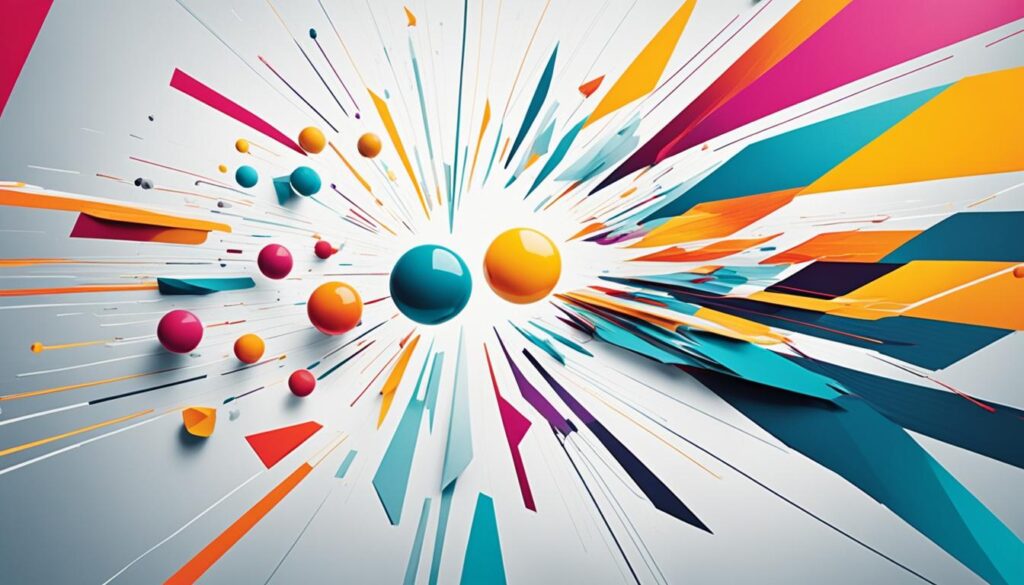
Product Vision and its Importance
At the core of every successful product lies a strategic cornerstone: the product vision. As design leaders, we understand the crucial role we play in defining and communicating this vision. It serves as a guiding light, aligning our design teams’ efforts towards a common goal and driving us towards success.
When shaping the product vision, we take into consideration various factors such as business goals, user needs, and market competitiveness. It goes beyond mere aesthetics and focuses on creating meaningful and innovative user experiences. We envision a product that not only meets the needs of our users but also exceeds their expectations, delighting them with its functionality and usability.
“A powerful product vision inspires creativity and innovation, igniting the passion of our teams and empowering them to push the boundaries of what’s possible.”
By crafting a clear and compelling product vision, we provide a sense of direction, ensuring that our design direction aligns with the strategic goals of our organization. It helps us navigate through the complexities of the design process, prioritize our efforts, and make informed decisions.
Furthermore, a well-defined product vision creates a shared understanding among stakeholders, from designers and developers to marketers and executives. It fosters collaboration and enables cross-functional teams to work cohesively towards a common goal.

“A strong product vision not only guides our design process, but it also resonates with our users, creating a lasting impact and fostering loyalty.”
As design leaders, we understand the importance of continuously refining and reassessing the product vision. We monitor market trends, gather user feedback, and stay attuned to evolving customer needs. This enables us to adapt and iterate our vision, ensuring that it remains relevant and impactful in an ever-changing landscape.
Designing with Purpose
By grounding our design decisions in the product vision, we are able to create experiences that not only meet the functional requirements but also connect with our users on a deeper level. We strive to anticipate their needs and desires, crafting intuitive and delightful experiences that resonate with them emotionally.
A product vision that is aligned with user experience principles allows us to design with purpose. It enables us to prioritize usability, accessibility, and inclusivity, ensuring that our products are not only beautiful but also inclusive and accessible to all users.
At the intersection of product vision and user experience, we have the power to transform lives, solve complex problems, and make a positive impact on the world.
| Benefits of a Strong Product Vision | Why Design Leaders Play a Crucial Role |
|---|---|
|
|
Conclusion
Design leadership is undergoing a significant transformation as design leaders expand their roles beyond aesthetics. The future of design leadership lies in embracing complexity, leveraging digital tools, and shaping sustainable and equitable visions. As design leaders, we have a unique opportunity to define design strategy, foster creativity and collaboration, mentor our teams, and advocate for the value of design.
By navigating the challenges and opportunities that lie ahead, we can play a pivotal role in shaping innovation, creativity, and the positive impact of design in our industry. Our strategic vision will guide us as we navigate the ever-changing landscape of design leadership, ensuring that our work goes beyond aesthetics and creates meaningful value for our stakeholders.
Design leadership is no longer just about creating beautiful products; it is about driving innovation, addressing complex challenges, and making a positive impact on society. As we harness the power of digitalization and AI, we must strike a balance between leveraging these tools and maintaining the human touch and empathy in our design process. By doing so, we can shape a future where design leadership plays a central role in creating sustainable and equitable solutions that meet the needs of our ever-evolving world.
Design leadership plays a crucial role in shaping the future of projects. By utilizing a human design calculator discovery, leaders can gain deeper insights into team dynamics and individual strengths. This understanding allows for more personalized and effective project planning, ultimately laying the groundwork for successful and innovative initiatives. Design leadership is the strategic role of guiding and shaping the direction of design. It involves anticipating future needs, leveraging digital capabilities, and creating value for stakeholders beyond customers.
Design thinking is an important aspect of design leadership. It addresses complex challenges and uses creativity to solve problems. It requires multidisciplinary teams and integrates knowledge from various fields like anthropology, sociology, and business modeling. Digitalization has transformed the role of design by offering new tools and methods for collaboration, scenario modeling, and validation of solutions. AI also plays a role in design, enabling new possibilities for creativity and problem-solving.
Design leaders have the opportunity to redefine boundaries, promote equity and sustainability, and shape future visions for positive impact. They should integrate empathy, creativity, and imagination to meet these challenges and contribute to positive change.
Design governance provides a foundation for scaling up design excellence and ensuring design integration within the company. It encompasses rules of engagement, design organization structure, and design taxonomy.
In the post-Covid world, design leaders should prioritize problem-finding over solutions, emphasize critical thinking, and focus on developing design competencies within their teams. They should also prepare for a future where AI takes on routine tasks.
AI presents both challenges and opportunities. Design leaders must navigate nuanced ethical considerations and use AI responsibly to preserve human creativity and respect intellectual property rights. They should integrate ethical guidelines and considerations into the creative process. Design leaders understand the importance of merging design thinking with strategic planning. Design is not just about aesthetics but should solve real-world problems and align with business goals. Design leaders bring a strategic perspective to design and ensure it aligns with business objectives.
Design leaders play a crucial role in defining and communicating the product vision. A clear and compelling product vision guides the design team, aligning their efforts towards a common goal. It goes beyond aesthetics and focuses on creating meaningful and innovative user experiences.
The future of design leadership involves embracing complexity, leveraging digital tools, and shaping sustainable and equitable visions. Design leaders have the opportunity to redefine boundaries, foster creativity and collaboration, mentor their teams, and advocate for the value of design.
How Can Design Leadership Help in Creating a Blueprint for Future Projects?
FAQ
What is design leadership?
How does design thinking contribute to design leadership?
How does digitalization impact design and design thinking?
How can design leaders promote equity and sustainability?
What is design governance?
How can design leaders adapt to the post-Covid world?
What are the ethical considerations of AI in design?
How does design align with business goals?
What is the importance of product vision?
What is the future role of design leadership?
- About the Author
- Latest Posts
Meet Katherine, the creative enthusiast at ByRetreat who infuses her boundless passion for design into every remote workspace she crafts. With an innate sense of creativity and an eye for unconventional beauty, Katherine brings a unique and inspiring perspective to the team.
Katherine’s love for design is infectious, and her ability to think outside the box sets her apart. She believes that true artistry lies in embracing a variety of styles and mixing them harmoniously to create captivating spaces. By combining different textures, colors, and patterns, Katherine weaves a tapestry of creativity that breathes life into each remote workspace.
Southeast Asia Decor
Understanding Batik’s Role in Modern Interior Design
Incorporate batik textiles into your interior design for a vibrant, cultural touch that enhances any space—discover how to elevate your home decor today!

Batik plays a significant role in modern interior design by adding cultural richness and vibrant aesthetics. You can use batik textiles in throw pillows, curtains, or wall art to create visual interest. The intricate patterns and colors not only showcase traditional craftsmanship but also complement natural materials like wood and stone. By mixing batik with solid colors, you can achieve a balanced look that feels both contemporary and warm. Plus, its durability makes it suitable for everyday use. Want to discover how to seamlessly integrate batik into your design scheme? There's much more to explore.
Key Takeaways
- Batik, with its vibrant colors and intricate patterns, enhances modern interiors, adding cultural richness and visual appeal.
- Incorporating batik textiles, such as throw pillows or wall art, creates unique focal points and layers in interior design.
- The durability of batik fabric makes it suitable for everyday use, allowing for creative expression in both residential and commercial spaces.
- Batik fosters cultural appreciation and dialogue, bridging cultural gaps and promoting diversity in design choices.
- Mixing batik with other materials can soften architectural lines and inspire seasonal updates, enriching the overall aesthetic of interiors.
Overview of Batik

Batik is a fascinating textile art form that originated in Indonesia, showcasing a unique wax-resist dyeing technique to create stunning patterns on fabric. This traditional craft involves applying hot wax to the fabric with a canting tool before immersing it in dye baths. Once the dyeing is complete, the wax is removed, revealing intricate designs that often reflect traditional motifs and cultural significance.
The term "batik" comes from the Javanese word "ambatik," meaning "cloth with little dots," which emphasizes the detailed craftsmanship behind this art. Additionally, the vibrant artistry of batik complements other traditional Indonesian art forms, such as Indonesian Decor Masks, creating a cohesive cultural aesthetic in interior spaces.
The patterns created through batik aren't just visually striking; they also symbolize various aspects of Indonesian life, including social status, nature, and virtues. As you explore modern applications, you'll find that batik has evolved remarkably, now incorporating contemporary designs that appeal to younger audiences.
Today, you can see batik making its mark in modern fashion and interior design, where its vibrant colors and intricate patterns bring life to various decor styles. Whether you're considering batik for clothing or home accessories, this textile art form offers a rich tapestry of history and creativity that enhances any setting.
Historical Significance

The rich history of batik reveals its deep cultural roots and significance in Indonesian society. Originating over 2,000 years ago on the island of Java, batik is one of the oldest textile traditions in the world. The term "batik" comes from the Javanese word "ambatik," which means cloth with little dots, perfectly reflecting its intricate designs and patterns.
Historically, batik served as a medium for spiritual expression, with each pattern embodying symbolic meanings tied to Indonesian culture and social status. The artistry of batik is celebrated in various forms, including traditional craftsmanship, showcasing unique designs that elevate any decor.
You'll find that batik garments often become cherished family heirlooms, representing cultural heritage and frequently worn during significant ceremonies and celebrations. This connection to identity and history resonates deeply within Indonesian culture, making batik not just a textile, but a narrative of tradition and pride.
Its historical significance has been recognized by UNESCO, which designates batik as an important cultural practice, promoting its preservation and appreciation across various societies. As you explore modern interior design, understanding batik's historical roots enhances your appreciation for how these beautiful textiles enrich contemporary spaces, connecting you to a vibrant cultural legacy.
Batik Techniques Explained

When you explore batik techniques, you'll discover the traditional wax-resist method that forms the backbone of this craft.
This intricate process involves applying wax to fabric to create stunning patterns, which are then dyed in vibrant colors.
Different regions showcase unique pattern variations, each reflecting local culture and artistry, making batik a versatile choice for Indonesian decorative pillows.
Understanding these techniques can enhance your appreciation of batik's role in modern interior design.
Traditional Wax-Resist Method
A fascinating aspect of the traditional wax-resist method lies in its intricate process, where artisans skillfully apply hot wax to fabric using tools like canting or stamps. This traditional batik technique is essential for creating stunning designs and patterns that captivate the eye, much like the importance of Indonesian decor masks that also embody rich cultural storytelling.
Once the wax is applied, the fabric is submerged in dye baths. The areas without wax absorb the dye, while the waxed regions remain untouched, preserving their original color. This unique dyeing process allows for a striking contrast, making each piece of batik fabric truly one-of-a-kind.
After the dyeing is complete, the fabric is heated to remove the wax, revealing the intricate patterns left behind. Various styles of batik, such as Batik Tulis, Batik Cap, and Batik Lukis, showcase the diversity in techniques and applications. Each style reflects not only the artisan's skill but also cultural heritage and modern artistic expressions.
Incorporating these traditional batik techniques into interior design can transform spaces, adding warmth and a rich narrative through unique patterns and vibrant colors.
You can enjoy the beauty of batik while connecting with its long-standing traditions and craftsmanship.
Regional Pattern Variations
Batik techniques across Indonesia showcase a vibrant tapestry of regional variations, each telling its own unique story through patterns and colors. You'll find that batik isn't just a craft; it's a reflection of cultural identity. For instance, Batik Tulis is hand-drawn and labor-intensive, while Batik Cap employs stamped designs for quicker production.
In coastal regions, Batik Pesisir features bright colors influenced by foreign cultures, whereas Batik Belanda merges Western elements with traditional Javanese designs. Each region presents distinct motifs that symbolize local culture and nature, like the Parang pattern representing power and the Kawung symbolizing fertility.
Here's a quick overview of some regional batik techniques:
| Batik Type | Characteristics | Notable Motifs |
|---|---|---|
| Batik Tulis | Hand-drawn, detailed | Parang, Kawung |
| Batik Cap | Stamped, quicker production | Various floral |
| Batik Pesisir | Bright, culturally influenced | Oceanic elements |
Understanding these variations enriches your appreciation of batik as a contemporary textile design, making it a perfect fit for modern interior spaces.
Batik in Modern Interiors
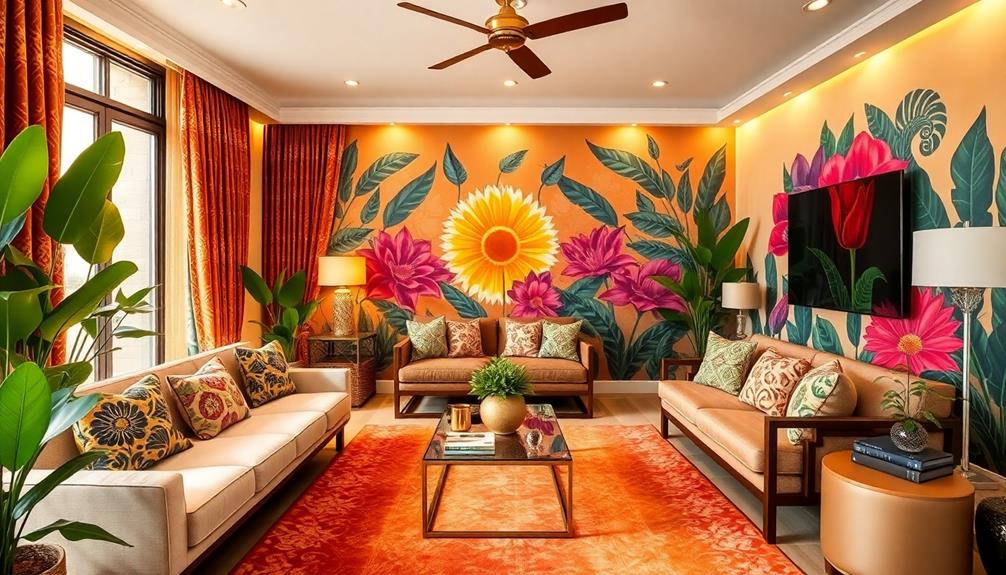
Incorporating batik into modern interiors breathes life into your space, merging vibrant colors and intricate patterns with contemporary design. Batik fabric serves as a versatile choice for decorative elements, whether you opt for throw pillows, curtains, or wall art.
These pieces not only enhance the aesthetic appeal but also showcase traditional craftsmanship, fostering cultural appreciation in your home. The use of natural materials in your decor, such as wood and stone, complements the rich textures of batik, creating a harmonious atmosphere that reflects local culture and promotes relaxation traditional Indonesian style home decor.
Using batik in upholstery can create eye-catching statement pieces that draw the eye and spark conversation. Additionally, smaller batik items subtly elevate your interior themes, providing impactful touches that complement various design aesthetics—from bohemian to minimalist.
You can mix batik with solid colors or other textiles to achieve a layered, cohesive look. With proper care, batik fabrics remain durable for everyday use in home decor, allowing you to express your creativity through unique patterns and textures.
This creative expression transforms your living space into a personal narrative, rich with stories and cultural significance. By embracing batik, you not only beautify your home but also celebrate a timeless art form that resonates with both tradition and modernity.
Practical Applications of Batik

There's no shortage of ways to incorporate batik into your modern interior design, making it a fantastic choice for adding character and warmth to your space. For a subtle touch, consider using decorative throw pillows or small accent pieces featuring batik patterns. These elements enhance visual interest without overwhelming your decor.
Additionally, incorporating batik allows you to embrace the beauty of traditional craftsmanship alongside modern aesthetics, which is a hallmark of Balinese design characteristics.
If you're looking to make a bold statement, think about upholstering furniture with batik or hanging large tapestries on your walls. These focal points showcase intricate patterns and vibrant colors that can transform a room. When you incorporate batik, make certain the color palette and design theme align with your existing decor for a cohesive look.
Mixing batik textiles with solid colors or other complementary materials creates a layered, dynamic appearance, adding depth to your overall design. Batik's versatility allows it to complement various styles, including bohemian, eclectic, and contemporary.
This adaptability offers a fantastic avenue for creative expression, whether in residential or commercial settings. So, don't hesitate to explore the many practical applications of batik in your space—you'll find it can truly enhance your modern interiors!
Design Integration Strategies
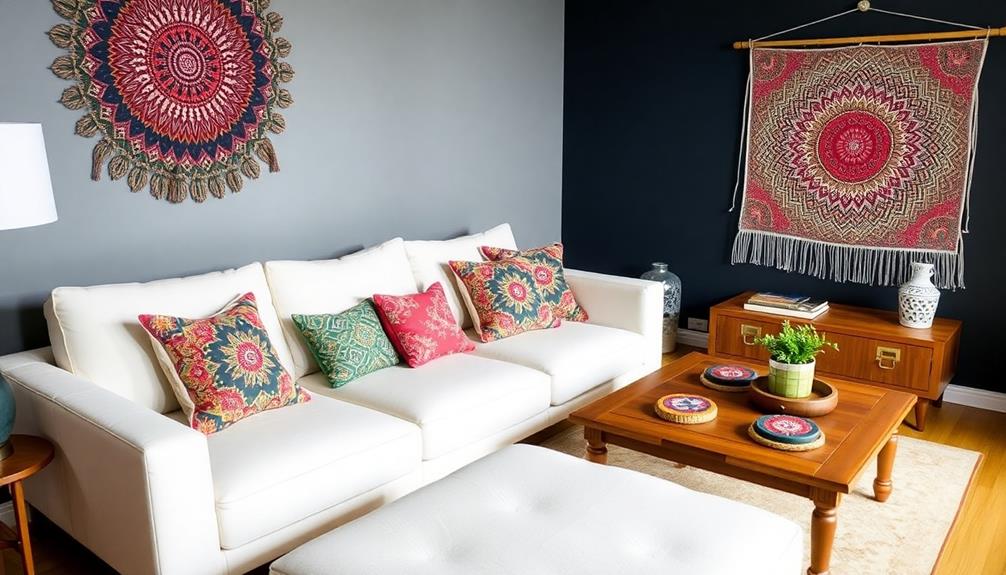
Integrating batik into your modern interior design can elevate your space with vibrant colors and unique patterns. You can easily incorporate batik textiles as accent pieces, such as throw pillows or wall art, to make a bold statement. When combining batik with other fabrics, choose solid colors or neutral tones to create a balanced look that highlights the intricate designs.
To help you visualize how to blend batik seamlessly, here's a quick guide:
| Strategy | Description |
|---|---|
| Use as Accent Pieces | Add throw pillows, wall art, or small decor items. |
| Mix with Solid Colors | Pair batik with neutrals for a balanced aesthetic. |
| Explore Various Design Styles | Integrate in bohemian or eclectic themes for visual interest. |
| Layer Textures and Patterns | Combine batik with different fabrics for depth. |
| Utilize in Larger Applications | Consider upholstered furniture or curtains for impact. |
Durability and Care
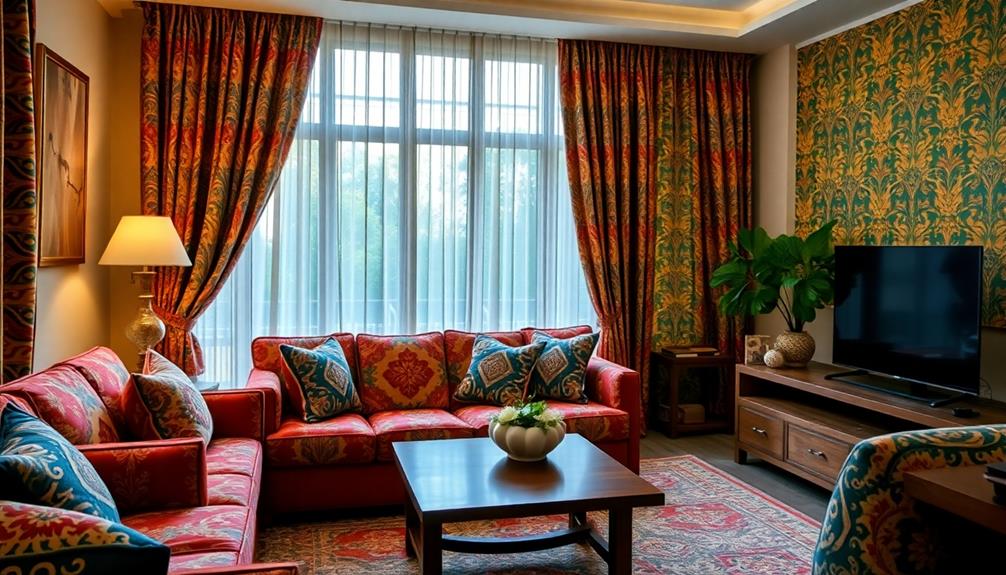
When it comes to durability and care, batik fabric stands out as a resilient choice for modern interiors, especially when you select the right base material. Its durability makes it an excellent option for upholstery, allowing you to incorporate its vibrant colors and unique patterns into your furniture.
Additionally, the careful selection of high-quality batik textiles can reflect regional identity and cultural importance, enhancing the overall aesthetic of your home traditional Indonesian housing. To maintain the integrity and beauty of batik fabric, it's essential to handle it with care. Ideally, you should have it hand washed or dry cleaned, steering clear of harsh chemicals and bleach that can lead to color degradation.
To further protect your batik textiles, dry them away from direct sunlight. This simple step can appreciably extend the life of the fabric, ensuring that those vibrant colors remain intact over time.
Opting for high-quality materials enhances the longevity of batik in your interior design, making it suitable for everyday use without sacrificing style. Regular care, combined with gentle handling and appropriate washing methods, will help preserve the unique patterns and colors that make batik such a standout choice for your home decor.
Global Influence on Batik
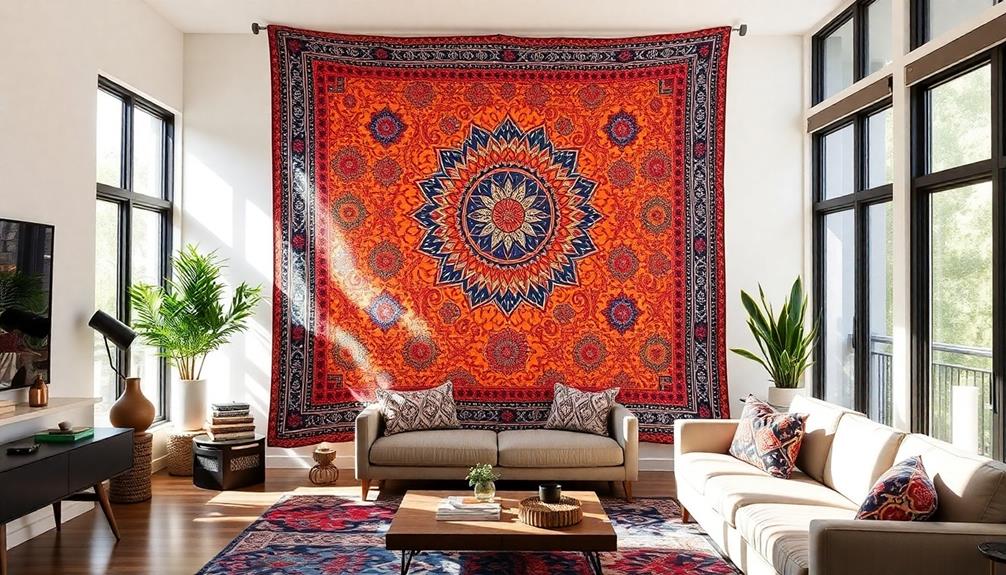
Batik's journey from traditional fabric to a global design phenomenon showcases its remarkable adaptability and appeal. In the 1800s, European traders brought batik to the forefront, leading to its exhibition in Dutch museums and inspiring artists across Europe. Today, designers from diverse backgrounds, like those in Belgium and Thailand, embrace batik techniques, reflecting its versatility in various fashion contexts.
| Global Influence | Description |
|---|---|
| Cultural Icons | Figures like Bill Gates and Beyoncé wear batik, highlighting its global significance. |
| Haute Couture | Renowned designers, including Diane von Furstenberg, incorporate batik in their collections. |
| Contemporary Trends | Modern aesthetics blend traditional motifs, appealing to younger audiences. |
| Ethnic Representation | Batik celebrates diverse ethnic groups and their decorative methods. |
Contemporary batik continues to thrive by merging its rich heritage with modern aesthetics, making it relevant not just in fashion but also in interior design. As you explore batik's influence, you'll discover how it transcends cultural boundaries, becoming a beloved textile that resonates with people worldwide.
Contemporary Trends in Batik

The resurgence of batik in contemporary design highlights its enduring charm and adaptability. You'll find that today's designers embrace sustainable materials like organic cotton and linen, reflecting a growing demand for eco-friendly interior decor.
Additionally, many interior design shops in Bali, such as those focusing on luxury tropical designs, incorporate batik patterns into their unique pieces, making them vibrant focal points in any living space. Batik patterns are increasingly featured in modern upholstery and accent pieces, making them vibrant focal points in any living space.
This trend merges traditional batik techniques with minimalist aesthetics, leading to innovative designs that resonate with a broader audience, especially younger consumers. High-end designer collections showcase batik-inspired textiles, proving their versatility across various interior styles, from bohemian to contemporary chic.
You can also explore the trend of mixing batik with other textiles, which allows for layered looks that create depth and visual interest. This approach not only enhances your interiors but also celebrates cultural heritage, weaving stories into your design choices.
Cultural Appreciation Through Batik
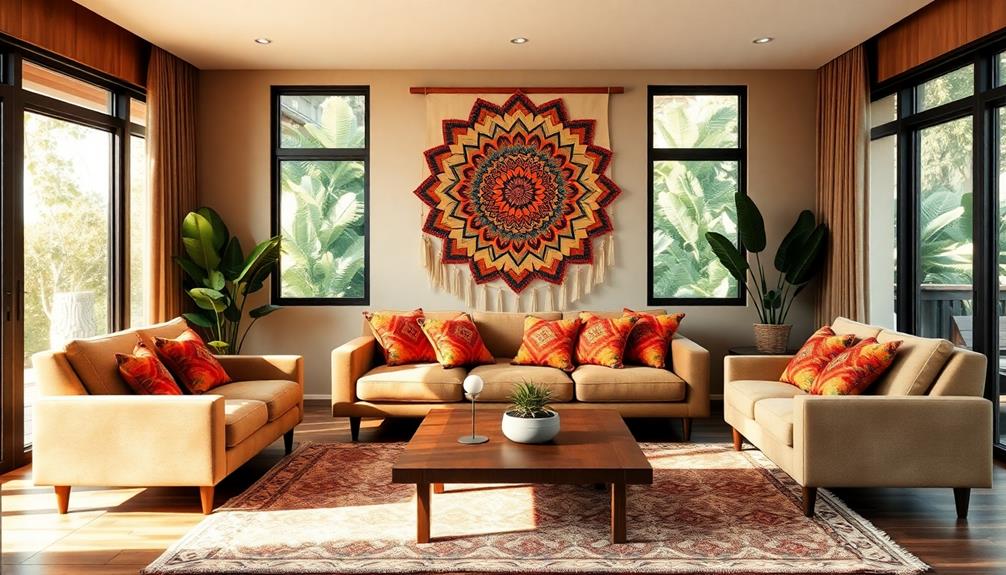
Modern interior design not only embraces batik for its aesthetic appeal but also celebrates its rich cultural heritage. By integrating batik motifs into your space, you invite a vibrant narrative that reflects the historical significance and traditional craftsmanship of Indonesian art. Each design carries meaning; for instance, the Parang motif symbolizes power and protection, connecting you to the deeper cultural identity of the region.
This appreciation for cultural artistry aligns with the principles of modern tropical aesthetics, where natural materials and storytelling play a pivotal role in design.
UNESCO recognizes batik as an essential cultural practice, underscoring its role in maintaining heritage and fostering cultural appreciation. When you incorporate batik into modern interiors, you create an engaging dialogue between traditional artistry and contemporary design aesthetics.
This blend not only enhances the visual appeal of your home but also encourages a profound understanding of the stories behind each pattern.
As you decorate, consider how these elements can bridge cultural gaps, allowing your space to resonate with the rich traditions of batik. Ultimately, batik isn't just a decorative choice; it's a celebration of a vibrant culture, inviting you and your guests to appreciate the artistry and significance woven into every fabric.
Frequently Asked Questions
What Is the Significance of Batik?
Batik's significance lies in its rich cultural heritage and artistry. You'll find its intricate patterns tell stories of identity and history, connecting you to traditions while inspiring creativity and appreciation for craftsmanship in everyday life.
What Are the 5 Major Types of Batik Design?
Imagine selecting vibrant Batik Pesisir for your beach house. The five major types of batik design include Batik Tulis, Batik Cap, Batik Lukis, Batik Pesisir, and Batik Belanda, each showcasing unique techniques and cultural influences.
What Is Modern Batik Used For?
Modern batik's used for upholstery, decorative pillows, curtains, and wall hangings. You'll find its vibrant colors and intricate patterns adding depth and character to your living spaces, making them feel unique and culturally rich.
What Are the Three Elements of Batik?
You'll find batik's charm lies in three delightful elements: the wax-resist dyeing technique that creates stunning visuals, natural fabrics like cotton or silk, and intricate patterns that tell enchanting cultural stories. Enjoy exploring!
Conclusion
Incorporating batik into modern interior design isn't just about adding color; it's like weaving a rich tapestry of culture and history into your space. By embracing this art form, you celebrate its timeless beauty and honor its heritage. Whether you're draping it on walls or using it in textiles, batik breathes life into your home, making it a unique reflection of your identity. So go ahead, let batik transform your interiors into a vibrant story waiting to be told.
- About the Author
- Latest Posts
Introducing Ron, the home decor aficionado at ByRetreat, whose passion for creating beautiful and inviting spaces is at the heart of his work. With his deep knowledge of home decor and his innate sense of style, Ron brings a wealth of expertise and a keen eye for detail to the ByRetreat team.
Ron’s love for home decor goes beyond aesthetics; he understands that our surroundings play a significant role in our overall well-being and productivity. With this in mind, Ron is dedicated to transforming remote workspaces into havens of comfort, functionality, and beauty.
Southeast Asia Decor
Why Batik Matters in Modern Interior Design
Get inspired by the cultural richness of batik in modern interior design and discover how it can transform your space in unexpected ways.

Batik matters in modern interior design because it weaves rich cultural heritage and intricate artistry into your spaces. Each pattern carries a unique story that connects to Indonesian history, adding personality to your decor. You can use batik textiles in versatile ways, from cushions to wall art, elevating the aesthetic of any room. The vibrant colors and distinctive designs create visual impact while celebrating craftsmanship. Plus, incorporating batik supports sustainable practices by promoting handcrafted work. If you want to further explore how batik can transform your interiors, there's plenty more to discover.
Key Takeaways
- Batik enhances modern interiors with vibrant patterns, adding cultural richness and visual interest to various design styles.
- Its unique patterns tell stories of heritage, connecting spaces to Indonesian culture and traditions.
- Batik textiles support sustainable practices by promoting handcrafted artisan work, appealing to eco-conscious consumers.
- The versatility of batik allows it to be used in accent pieces, creating focal points without overwhelming decor.
- Contemporary adaptations of batik merge traditional artistry with modern aesthetics, attracting a younger audience and revitalizing interest in this cultural heritage.
The Cultural Heritage of Batik

Batik's rich cultural heritage is woven into the social fabric of Indonesia, particularly in Java, where this ancient textile art form has thrived for over 2,000 years.
You'll find that batik fabrics are more than just beautiful textiles; they embody the history and values of Indonesian society. The intricate traditional patterns often carry profound meanings, representing social status, nature, and virtues.
Additionally, the artistry of batik complements other traditional Indonesian decor elements, such as Indonesian Decor Masks, which also reflect the country's cultural narratives.
In 2009, UNESCO recognized batik as a Masterpiece of Oral and Intangible Heritage, underscoring its importance and the artisanal craftsmanship behind it.
When you explore batik, you'll notice the distinct regional styles, such as Batik Tulis (hand-drawn) and Batik Cap (stamped). Each style reflects local traditions and influences, showcasing Indonesia's rich cultural diversity.
Batik holds a significant role in various ceremonial contexts, often adorning traditional clothing for weddings, festivals, and other cultural celebrations.
The Batik Creation Process

At the heart of batik lies a meticulous creation process that transforms natural fabrics into stunning works of art. You start with a fabric like cotton or silk, stretching it on a frame to prepare for your design. Using a canting tool, you draw intricate patterns by applying hot wax, which is essential in the batik process.
Once the wax is applied, the fabric is immersed in dye baths, soaking up vibrant colors. Significantly, the Face Indonesian Decor Mask showcases the same level of intricate craftsmanship found in batik designs. Afterward, you remove the wax through heating, revealing the beautiful batik designs underneath.
Traditional batik techniques include Batik Tulis, a labor-intensive method where designs are hand-drawn, and Batik Cap, which utilizes copper stamps for quicker production.
Layering colors is a hallmark of this art form, often requiring multiple rounds of waxing and dyeing to achieve complex designs. Fundamental tools in the batik process, like the canting for detailed work and natural dyes sourced from plants, roots, and bark, enhance the authenticity and richness of your creations.
Patterns and Their Meanings

Patterns in batik are more than just beautiful designs; they carry deep meanings that enrich the spaces they adorn. Each batik pattern tells a story, connecting you to the cultural significance of Indonesian heritage.
For instance, the Parang pattern symbolizes power and protection, while Kawung represents fertility and prosperity. Incorporating these handcrafted textiles can elevate your decor, making it not only visually appealing but also culturally resonant, as seen with Indonesian Decorative Pillows. When you choose these motifs for your interior design, you're infusing your home with a rich narrative.
Moreover, specific patterns like Sido Asih, which signifies love, make batik an evocative choice for personal spaces or romantic settings. The geographical influences behind these designs reflect local nature and traditions, offering a profound connection to the environment and philosophies of the region.
Contemporary batik patterns blend traditional symbolism with modern aesthetics, appealing to diverse audiences and enhancing the cultural depth of your decor.
Batik's Role in Modern Design
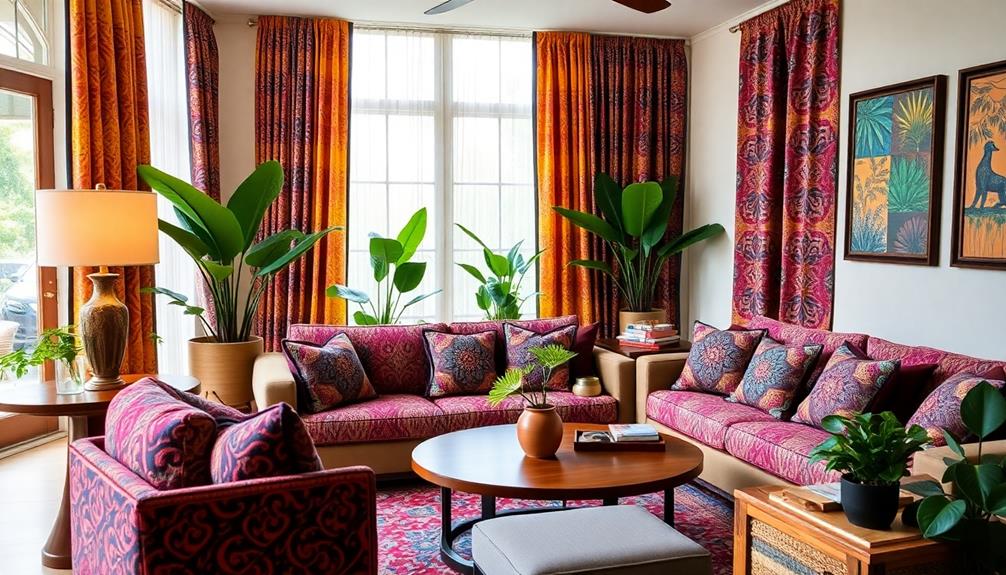
Batik plays an essential role in modern design by integrating cultural heritage into contemporary spaces. Its intricate patterns and vibrant colors resonate well with traditional Indonesian style home decor, allowing for a seamless blend of history and sophistication.
You can find its versatile applications in everything from luxurious accent pieces to bohemian-style interiors, making it a go-to choice for many decorators. With its unique patterns and colors, batik adds a contemporary aesthetic appeal that balances tradition and modernity.
Cultural Heritage Integration
Incorporating batik textiles into modern interior design not only enhances aesthetic appeal but also weaves a rich tapestry of cultural heritage into your living spaces. These vibrant patterns and symbolic motifs tell stories, reflecting the traditional uses and artistic expression of Indonesian culture. By using batik in cushions, curtains, and upholstery, you celebrate cultural diversity while creating unique, visually appealing environments.
Integrating batik into your decor not only honors craftsmanship but also supports sustainable practices, as many pieces are handcrafted by local artisans. This approach fosters a deeper appreciation for traditional textile arts in a global context, contributing to the preservation of this cultural heritage.
| Aspect | Batik's Significance |
|---|---|
| Cultural Heritage | Represents Indonesian traditions |
| Traditional Uses | Historically used in clothing |
| Artistic Expression | Showcases intricate designs and stories |
Versatile Design Applications
Embracing vibrant batik textiles in your home can transform spaces, making them visually striking and culturally rich. These textiles offer a unique blend of traditional motifs and contemporary design, allowing you to create an inviting atmosphere.
You can use batik textiles as accent pieces, such as throws, cushions, and curtains, to add depth and personality to your decor. Additionally, incorporating Indonesian decor masks alongside batik can further enhance the cultural narrative of your space, showcasing the artistry and craftsmanship of Indonesia.
Batik's versatility means it fits seamlessly into various design styles, from rustic to modern fashion. When incorporating batik, consider mixing these bold patterns with solid colors to strike a balance in your room's aesthetic. Using batik in small doses can also prevent overwhelming the space, ensuring that the vibrant designs enhance rather than dominate.
Beyond fabric, batik motifs can enrich your home in other ways, appearing on wallpaper, upholstery, and wall-mounted panels. This adaptability allows for a cohesive design narrative that celebrates cultural heritage while embracing modern aesthetics.
Contemporary Aesthetic Appeal
The vibrant allure of batik textiles is making waves in modern interior design, adding a distinctive flair to various spaces. You'll find that batik-inspired textiles are increasingly featured in contemporary aesthetics, enhancing homes with their vibrant patterns and rich cultural heritage.
Luxury brands are now interpreting batik in fresh ways, using it for accent pieces like throws, cushions, and curtains that seamlessly blend into various design styles. Incorporating traditional batik patterns can also mirror the intricate designs seen in Indonesian wedding decor ideas, adding depth and meaning to your interior spaces.
Imagine incorporating the intricate designs of batik as focal points within your modern bohemian interiors. Using batik in wall-mounted panels or upholstery creates a striking visual impact that draws attention.
To maintain a balanced look, mix batik with solid colors in your decor; this way, you can showcase the unique artistry without overwhelming the room.
Contemporary designers are embracing batik in their collections, reflecting an ongoing trend that merges traditional craftsmanship with modern aesthetic sensibilities.
By including batik in your interior design, you not only celebrate its beauty but also connect with its rich history, making your space both stylish and meaningful.
Incorporating Batik Into Interiors

Batik textiles can transform your interior spaces with their vibrant patterns and rich cultural heritage. By incorporating batik fabrics into your home, you can enhance your interior decor, making it both visually striking and culturally significant.
Use batik as accent pieces—think curtains, cushions, or upholstery—to add that pop of color and unique texture. Traditional Indonesian housing, with its emphasis on cultural symbolism, often inspires the use of such textiles, creating a connection to heritage and community spirit traditional Indonesian housing.
To create a modern bohemian aesthetic, consider integrating batik into wall-mounted panels or art displays. This approach not only serves as a unique focal point but also allows you to showcase the beautiful craftsmanship of traditional batik designs.
When mixing batik with other elements, choose patterns that complement your existing decor. Pair batik with solid colors to prevent overwhelming a room.
Batik fabrics are incredibly versatile, fitting seamlessly into various design styles, whether you lean towards traditional or contemporary. Antique-inspired batik textiles can contribute historical significance and uniqueness, enriching your space with a layered and inviting atmosphere.
Contemporary Trends in Batik

Modern design enthusiasts are increasingly drawn to contemporary batik, which marries traditional artistry with innovative aesthetics. You'll find that contemporary batik appeals to a younger audience, enhancing interior decor with its vibrant colors and intricate patterns.
Luxury brands are now offering batik-inspired textiles, making them popular choices for accent pieces in modern bohemian interiors. This trend complements the rising interest in unique decor discoveries, such as those found in Bali interior shops, where local artisans create stunning pieces that reflect cultural heritage.
As you explore this trend, you'll notice batik fabric being used in various interior design elements, from cushions to curtains and upholstery. This versatility contributes to a culturally rich atmosphere while maintaining a stylish look.
Designers are experimenting with batik in everything from traditional to minimalist styles, allowing it to seamlessly fit into diverse decor themes.
Moreover, the shift towards sustainable and handmade products has further bolstered the popularity of batik. This trend emphasizes artisanal craftsmanship, connecting you to a cultural heritage that feels both authentic and modern.
Global Influence and Recognition

Batik's cultural heritage revival is evident as it gains global attention, celebrated for its craftsmanship and storytelling.
Its intricate patterns and vibrant colors align beautifully with the principles of modern tropical aesthetics in Bali, where natural materials and open spaces create a harmonious living environment.
You'll see its influence in high fashion, with designers fusing traditional motifs into modern collections.
This evolution of artistic expression showcases batik's ability to resonate across diverse cultures and settings.
Cultural Heritage Revival
Recognized globally for its intricate designs and rich cultural heritage, batik has seen a remarkable revival in contemporary society. This traditional Indonesian fabric, celebrated for its unique patterns and craftsmanship, has gained significant recognition since UNESCO designated it a Masterpiece of Oral and Intangible Heritage in 2009.
The revival of batik goes beyond fashion; it reflects a broader appreciation for cultural heritage in modern design. As interior spaces increasingly embrace natural materials and textures, batik textiles provide a vibrant contrast that amplifies the warmth and authenticity of a room.
You'll notice batik fabric making its way into homes and commercial spaces, creating vibrant atmospheres that celebrate its origins. Events like National Batik Day on October 2nd further promote this appreciation, encouraging people to engage with and honor this cultural treasure.
Celebrities like Barack Obama and Beyoncé, who've donned batik-inspired garments, amplify its visibility and recognition, showcasing its versatility.
As you explore modern interior design, you'll see how batik textiles can transform your space, merging contemporary aesthetics with a rich history. This revival not only honors the craftsmanship of traditional Indonesian artisans but also invites you to partake in a global movement that celebrates and preserves cultural heritage through design.
Global Fashion Integration
The integration of batik into global fashion showcases its dynamic evolution from a traditional textile to a contemporary style statement. You'll notice how batik motifs have shifted through time, gaining recognition and respect across various cultures.
Here are three key aspects of this transformation:
- Historical Influence: Batik gained international recognition in the 19th century, when European traders popularized it, leading to its display in Dutch museums.
- Celebrity Endorsements: High-profile figures like Barack Obama and Beyoncé have donned batik garments, amplifying the fabric's visibility on global platforms.
- Modern Fusion: Local designers are blending traditional craftsmanship with modern aesthetics, creating fresh collections that resonate with younger audiences.
Batik's presence in haute couture illustrates its versatility and ability to bridge cultural divides. This fusion not only keeps the art form relevant but also celebrates its rich heritage.
Artistic Expression Evolution
As you explore the evolution of artistic expression, you'll find that batik has transcended its Indonesian roots to become a celebrated global art form. This intricate art of batik, characterized by vibrant colors and unique patterns, has notably influenced contemporary interior design.
Traditional clothing adorned with batik motifs, such as Parang and Kawung, tells cultural stories while serving as stunning focal points in modern decor.
In the 19th century, batik gained traction in Europe, inspiring renowned artists and designers. Its incorporation into high-end fashion and luxury home textiles further solidified its status.
In 2009, UNESCO recognized batik as a Masterpiece of Oral and Intangible Heritage, which not only affirmed its cultural significance but also encouraged designers to weave traditional techniques into their modern creations.
Today, you can see batik making waves in interior design through upholstery, curtains, and decorative accents. This contemporary use bridges the gap between cultural heritage and modern aesthetics, allowing you to appreciate the art of batik in everyday spaces.
Frequently Asked Questions
How Can I Care for Batik Fabrics at Home?
To care for batik fabrics at home, wash them gently in cold water with mild detergent. Avoid bleach and wringing. Hang them to dry in the shade, ensuring colors stay vibrant and fabric remains intact.
Are There Specific Colors in Batik That Symbolize Certain Emotions?
Yes, in batik, specific colors do symbolize emotions. For instance, red often represents courage or passion, while blue signifies tranquility. By choosing certain colors, you can evoke desired feelings in your space or attire.
What Types of Materials Are Commonly Used in Batik Production?
Imagine the vibrant dance of colors on fabric; cotton, silk, and rayon are the primary materials used in batik production. Each fabric type absorbs dye differently, enhancing the artistry and uniqueness of the final piece.
Can Batik Be Used in Outdoor Decor Settings?
Yes, you can definitely use batik in outdoor decor settings. Its vibrant colors and unique patterns add character to spaces. Just guarantee the fabric's durability against the elements to keep it looking fresh and beautiful.
How Do I Choose the Right Batik Pieces for My Space?
To choose the right batik pieces for your space, consider your existing color palette, the size of the area, and the overall vibe you want. Don't hesitate to mix patterns for a unique touch!
Conclusion
Batik's beautiful blends of culture and creativity can transform your space into a stunning sanctuary. By embracing its intricate artistry, you not only honor tradition but also elevate your interior design. As you weave these wondrous textiles into your home, you'll witness the perfect marriage of heritage and modernity. So, why not let batik breathe life into your living areas? Immerse yourself in this delightful design journey and discover how batik can brighten your world!
- About the Author
- Latest Posts
Introducing Ron, the home decor aficionado at ByRetreat, whose passion for creating beautiful and inviting spaces is at the heart of his work. With his deep knowledge of home decor and his innate sense of style, Ron brings a wealth of expertise and a keen eye for detail to the ByRetreat team.
Ron’s love for home decor goes beyond aesthetics; he understands that our surroundings play a significant role in our overall well-being and productivity. With this in mind, Ron is dedicated to transforming remote workspaces into havens of comfort, functionality, and beauty.
Southeast Asia Decor
Batik: Cultural Symbolism in Modern Interior Design
Key to enhancing modern interiors, batik’s vibrant patterns tell stories of culture and craftsmanship; discover how to transform your space with meaningful design.
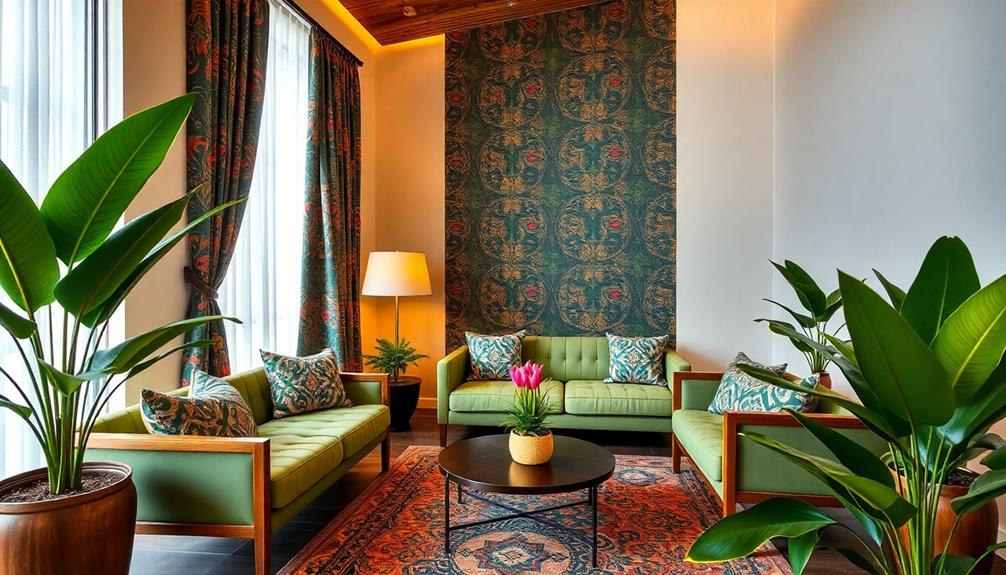
Batik isn't just a beautiful textile; it's a vibrant cultural symbol that enriches modern interior design. You can incorporate its intricate motifs and bright colors into your home, enhancing both aesthetics and storytelling. Each pattern holds meaning, like the Kawung symbolizing balance or Parang representing strength. These designs can be used in cushions, curtains, and art pieces, bringing depth and emotion to your space. By integrating batik, you're not just decorating; you're connecting your environment to a rich heritage. If you explore further, you'll uncover how batik transforms interiors into narratives of culture and craftsmanship.
Key Takeaways
- Batik's intricate motifs reflect cultural values, enhancing narratives, and transforming interior spaces into rich tapestries of stories.
- Contemporary batik blends traditional designs with modern aesthetics, making it suitable for various decor elements like cushions and curtains.
- Regional variations in batik patterns showcase Indonesia's diverse cultural heritage, enriching interior design with unique symbolic meanings.
- Incorporating sustainable materials and eco-friendly practices in batik production supports local artisans and preserves cultural heritage.
- Batik's global influence and recognition as a cultural symbol elevate its significance in modern interior design, connecting spaces to deeper narratives.
Historical Significance of Batik
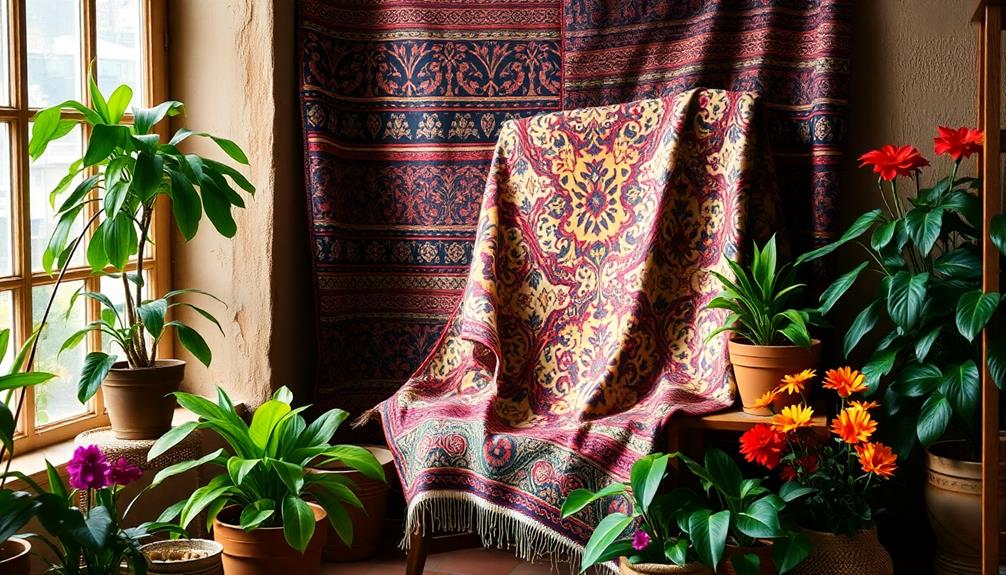
Although batik may seem like just a beautiful textile to you, its historical significance runs deep, rooted in over 2000 years of tradition originating in Indonesia. The term "batik" comes from the Javanese word "ambatik," meaning cloth with little dots, which reflects the intricate dyeing techniques that define this ancient art form.
The vibrant colors and intricate designs found in batik are reminiscent of other Indonesian handicrafts, such as the unique artistic expressions seen in traditional decor masks.
Originally, Indonesian batik was used for spiritual expression and ceremonial garments, with designs and motifs carrying symbolic meanings significant to the culture. The beauty of batik isn't just in its appearance; it embodies stories and traditions passed down through generations.
As various cultures embraced batik, distinct styles emerged, showcasing bolder colors in African batik and intricate patterns in Thai batik, yet the core essence remains rooted in its Indonesian origins.
In 2009, UNESCO recognized batik as a Masterpiece of Oral and Intangible Heritage, underscoring its cultural heritage and artistic importance. This acknowledgment not only highlights batik's historical significance but also guarantees its preservation for future generations.
The Batik Production Process

Batik's rich history is beautifully intertwined with its intricate production process, which transforms simple fabrics into stunning works of art. You start with natural fabrics like cotton or silk, stretching them on a frame for applying designs.
The batik process begins as you use a canting tool to apply hot wax, creating intricate patterns through a wax-resist dyeing technique. This step is crucial, as the hot wax forms a barrier that prevents dye from penetrating certain areas of the fabric. Indonesian decorative pillows often showcase batik patterns, adding a vibrant touch to any living space.
Once the wax is in place, you submerge the fabric in dye baths to achieve vibrant colors. Traditional batik often involves multiple rounds of waxing and dyeing, allowing for layered colors and complex patterns, especially in the Batik Tulis technique.
After dyeing, you remove the wax by heating the fabric, which reveals the beautiful designs underneath.
The final steps include boiling the fabric to eliminate wax residues, drying it thoroughly, and soaking it in a color-fixing solution to guarantee the longevity of the dyes.
This meticulous batik process results in unique and enchanting textiles that can enhance any modern interior design.
Cultural Symbolism of Batik Motifs

Batik motifs are more than just beautiful designs; they carry rich symbolic meanings that reflect cultural values. The intricate patterns often draw inspiration from traditional art forms, such as Indonesian Decor Masks, showcasing the depth of the nation's artistic heritage.
You'll find that regional variations add layers of significance, showcasing the diversity within Indonesian traditions. As you explore contemporary interpretations, you'll see how these motifs continue to influence interior design and personal expression today.
Symbolic Meanings of Motifs
In the world of interior design, the symbolic meanings behind batik motifs add depth and character to any space. These traditional patterns carry rich cultural importance, transforming everyday life into a tapestry of stories.
For instance, the Kawung motif represents balance and stability, derived from the aren palm tree, while the Parang design signifies strength and royalty, reflecting power and protection in Javanese culture. Additionally, these motifs echo the intricate artistry found in Indonesian decor masks, enhancing the cultural narrative within your home.
Integrating these motifs into your decor not only enhances aesthetic appeal but also connects your space to a deeper narrative.
The Udan Liris pattern symbolizes fertility, reminiscent of nourishing drizzle, making it a popular choice for celebrations of life. Meanwhile, the Sido Mukti design, often worn at weddings, signifies joy and prosperity, encapsulating positive beginnings in marriage.
Finally, the Cakar Ayam motif emphasizes diligence and prosperity, often worn by parents of brides, highlighting the cultural importance of family support in marriage traditions.
Regional Variations in Design
Exploring the diverse regional variations in batik designs reveals a fascinating tapestry of cultural symbolism that enriches interior spaces. Each region in Indonesia contributes its unique batik patterns, showcasing different aspects of Indonesian culture.
For instance, traditional Javanese designs, like the Kawung, symbolize balance and stability, while the Mega Mendung motif conveys calmness and patience. These beautiful patterns often reflect local folklore and spiritual beliefs, and can be harmoniously integrated into Balinese interior design concepts, which prioritize natural materials and earth tones for a calming effect Balinese design characteristics.
In contrast, coastal batik, known as Batik Pesisir, features bolder colors and intricate designs influenced by trade and multicultural exchanges, setting it apart from inland styles. Bali's batik designs highlight the island's connection to nature, depicting local flora and fauna as a form of artistic expression.
Moreover, unique motifs such as Parang are traditionally associated with nobility in Java, emphasizing the social hierarchy within Indonesian society.
Understanding these regional variations allows you to appreciate the cultural symbolism embedded in each batik design, creating a richer narrative for your interior spaces. By incorporating these diverse batik patterns, you can infuse your home with a deeper meaning that celebrates the rich heritage and artistic expression of Indonesian culture.
Contemporary Interpretations and Usage
When you incorporate contemporary interpretations of batik motifs into your home, you're not just adding vibrant colors and intricate designs; you're also weaving a narrative of cultural heritage into your living space.
These batik motifs, like Mega Mendung and Kawung, blend traditional patterns with modern aesthetics, making them perfect for various home decor styles. Designers in Bali, such as Mahallati Interiors, focus on blending natural elements with modern luxury, which can inspire your use of batik in decor.
Using batik in items such as cushions, curtains, and wall art allows you to express your individuality while creating a culturally rich atmosphere. This approach enhances your interior design by infusing it with emotional significance, reflecting values like unity and serenity through motifs like Sido Luhur and Gurdo.
Moreover, many designers are now focused on sustainable materials and eco-friendly practices in batik production. This not only promotes environmentally conscious design but also adds depth to your decor choices.
Contemporary Applications in Design
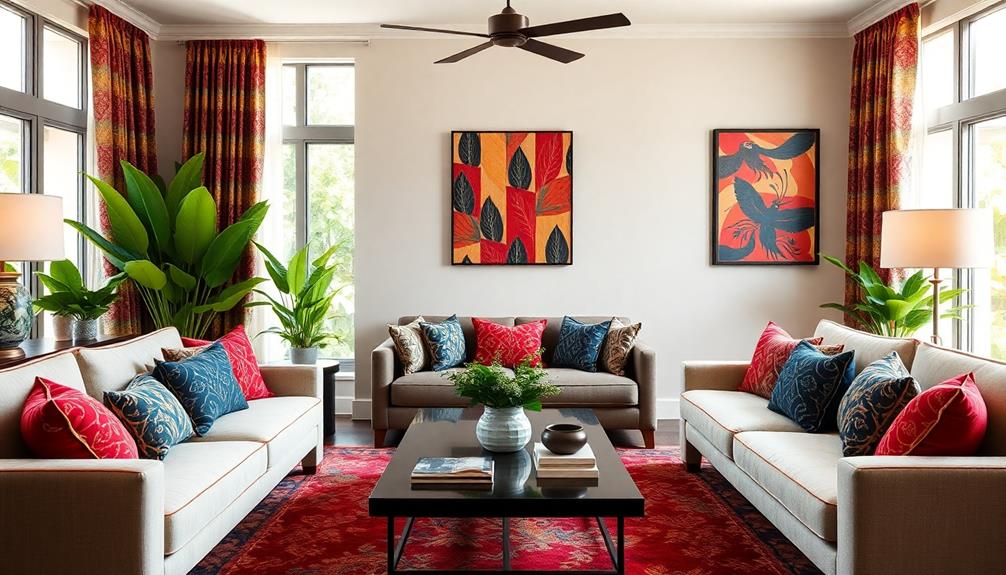
Batik is making a vibrant comeback in contemporary interior design, bringing its rich patterns and colors into modern living spaces.
You'll find batik fabric woven into a variety of accent pieces like cushions, curtains, and upholstery, adding cultural richness and unique visual interest to your home. Designers are skillfully blending traditional motifs with contemporary aesthetics, creating versatile home decor items that resonate with both heritage and modern style.
This approach mirrors the emphasis on using natural materials and traditional textiles seen in traditional Indonesian style home decor, enhancing aesthetic appeal.
Consider incorporating batik as a focal point in your space. Wall-mounted batik panels or art pieces can showcase the intricate craftsmanship of this textile art form, instantly elevating a room's design.
The growing popularity of batik in interior design reflects a broader trend of integrating cultural textiles into modern spaces, promoting global awareness and appreciation for artisanal practices.
Integrating Batik Into Interiors
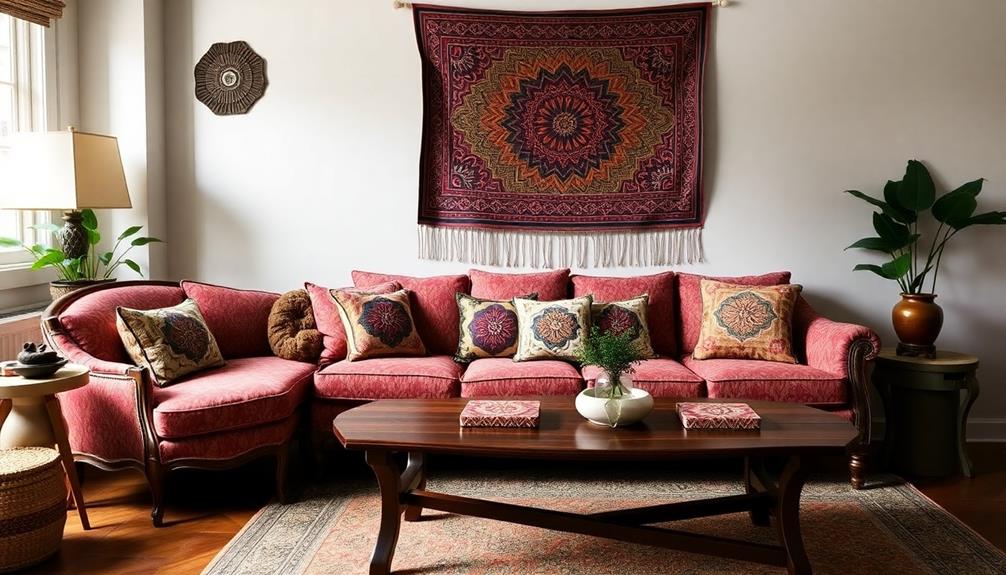
Incorporating batik into your interior design can bring a unique flair to your home while celebrating its cultural significance. Batik textiles, known for their vibrant patterns and rich heritage, enhance interior decor through cushions, curtains, and tablecloths. This perfect blend of traditional craftsmanship and modern design suits various styles, from bohemian to contemporary aesthetics.
To help you visualize how to integrate batik into your home, consider the following table:
| Element | Description |
|---|---|
| Cushions | Add color and comfort with batik prints. |
| Curtains | Create a stunning backdrop for any room. |
| Antique Batik | Use as focal points for visual interest. |
| Accent Pieces | Incorporate batik in small doses to avoid overwhelming your space. |
| Upholstery | Showcase the versatility of batik in functional furniture. |
Batik Techniques and Styles

Exploring batik techniques reveals a fascinating tapestry of artistry and tradition, each method offering unique characteristics.
You'll find that traditional batik-making primarily includes Batik Tulis, where skilled artisans hand-draw intricate designs using hot wax. This painstaking process results in exquisite patterns that showcase creativity and often incorporates cultural symbolism, reflecting the rich heritage of Indonesia's traditional housing styles.
On the other hand, Batik Cap utilizes copper stamps for quicker production, allowing for more widespread use of batik fabrics.
The dyeing technique in batik often involves applying wax, dyeing with natural colors derived from plants and minerals, and ultimately removing the wax to disclose detailed motifs.
If you're interested in modern adaptations, Batik Lukis allows for painting on fabric, merging traditional methods with contemporary artistic expression.
Don't overlook Batik Pesisir, which reflects coastal influences, characterized by bolder colors and designs aimed at commercial markets.
Finally, Batik Belanda combines Western elements with Javanese traditions, illustrating how batik adapts and evolves across cultures.
Whether you're drawn to the elegance of cotton or silk batik fabrics, each style offers something distinct for your interior design choices.
Global Influence on Batik

The intricate techniques and vibrant styles of batik have sparked a global fascination since the 1800s, as European traders introduced this unique art form to a wider audience. You can see batik's global influence in various facets of modern life, where it's embraced by international fashion designers and celebrated in contemporary styles.
| Cultural Impact | Examples |
|---|---|
| Fashion | Collections with traditional motifs |
| Decorative Arts | Adaptations in modern textiles |
| Global Reach | Influences in Nigeria, Ghana, India |
| Heritage | Recognized as a cultural symbol |
As Dutch and French artists adapted batik techniques, they contributed to the evolution of modern decorative arts, showcasing how versatile this art form can be. Today, you might spot batik on haute couture runways or worn by celebrities, further solidifying its status as a cultural symbol. The art form continues to adapt, merging with local textiles and reflecting diverse heritage, while maintaining its traditional motifs. This blend of history and innovation makes batik a fascinating subject in the world of design.
Celebrating Local Artisans and Craftsmanship

Through the revival of batik in interior design, local artisans and their craftsmanship are gaining the recognition they deserve. Supporting these artisans sustains traditional craftsmanship and fosters community development and economic growth in Indonesia.
You'll find that many batik artisans employ sustainable practices, using natural dyes and eco-friendly processes that enhance the cultural and environmental value of their work. Additionally, the integration of batik with tropical-themed luxury designs can elevate the aesthetic appeal of modern interiors.
Collaborations between designers and local artisans have led to the creation of unique, contemporary products that honor traditional techniques while appealing to modern consumers. This resurgence of batik in interior design showcases the intricate craftsmanship of local artisans in home decor items like cushions, curtains, and wall art.
Moreover, batik workshops and exhibitions are essential in highlighting the skills of these craftsmen. They provide educational opportunities that promote appreciation for this cultural heritage, especially among younger generations and tourists.
Frequently Asked Questions
What Is the Cultural Significance of Batik?
Batik's cultural significance lies in its rich history, representing diverse traditions and social values. Each motif tells a story, connecting you to community bonds and significant life events, while preserving cultural identity and artisanal craftsmanship.
What Does the Batik Symbolize?
You might think batik's just pretty fabric, but it symbolizes deep cultural heritage and identity. Each intricate pattern tells a story, revealing meanings like balance, power, and protection that connect you to rich traditions.
What Is the Basis of Modern Batik Design?
Modern batik design blends traditional motifs with contemporary aesthetics, appealing to diverse audiences. You'll find it utilizes sustainable materials and synthetic dyes, ensuring vibrant patterns while catering to eco-conscious consumers and fast-paced market demands.
What Is the Meaning of Batik Pattern Design?
Batik pattern designs carry rich meanings, reflecting cultural values and stories. Each motif you see symbolizes different beliefs, like balance, protection, or fertility, making your space not just beautiful but also meaningful and connected to heritage.
Conclusion
Incorporating batik into modern interior design not only enhances your space but also connects you to a rich cultural tapestry. By embracing the intricate motifs and techniques of this ancient art form, you celebrate both heritage and creativity. As you adorn your home with these vibrant textiles, you're not just decorating; you're telling a story that transcends time, much like a finely aged wine that only gets better with each passing year. So, go ahead and let batik inspire your surroundings!
- About the Author
- Latest Posts
Introducing Ron, the home decor aficionado at ByRetreat, whose passion for creating beautiful and inviting spaces is at the heart of his work. With his deep knowledge of home decor and his innate sense of style, Ron brings a wealth of expertise and a keen eye for detail to the ByRetreat team.
Ron’s love for home decor goes beyond aesthetics; he understands that our surroundings play a significant role in our overall well-being and productivity. With this in mind, Ron is dedicated to transforming remote workspaces into havens of comfort, functionality, and beauty.
-

 Retreat2 weeks ago
Retreat2 weeks agoDIY Aromatherapy Diffusers for a Spa-Like Atmosphere at Home
-

 Retreat3 weeks ago
Retreat3 weeks agoThe Profitability of Retreat Centers: A Financial Analysis
-

 Retreat1 week ago
Retreat1 week ago10 Unique Themed Room Ideas for Your Retreat Center
-

 Southeast Asia Decor1 week ago
Southeast Asia Decor1 week agoIndonesian Textiles Shaping Contemporary Interior Design
-

 Retreat2 weeks ago
Retreat2 weeks agoThe Psychology of Color in Retreat Center Design
-

 Retreat2 weeks ago
Retreat2 weeks agoUnusual DIY Projects: Designing a Space Probe in Bitlife
-

 Retreat3 weeks ago
Retreat3 weeks agoComprehensive Review: Are Home Decorators Ceiling Fans Worth the Investment?
-

 Retreat2 weeks ago
Retreat2 weeks agoHow to Create a Zen Garden for Your Retreat Center
















